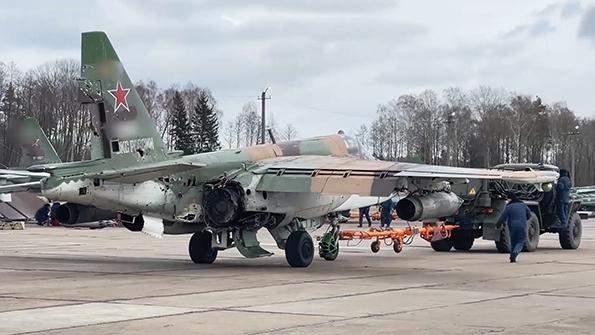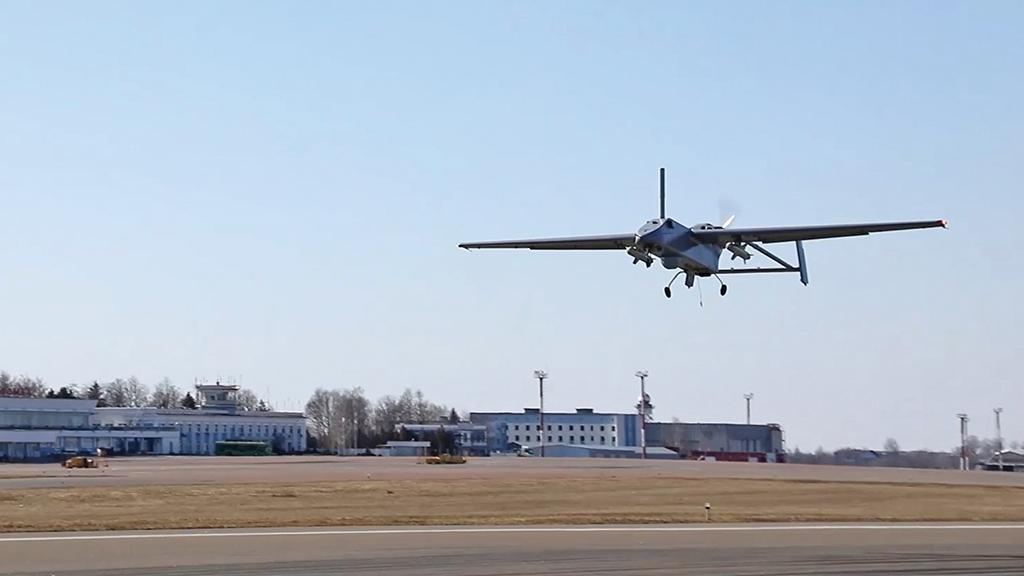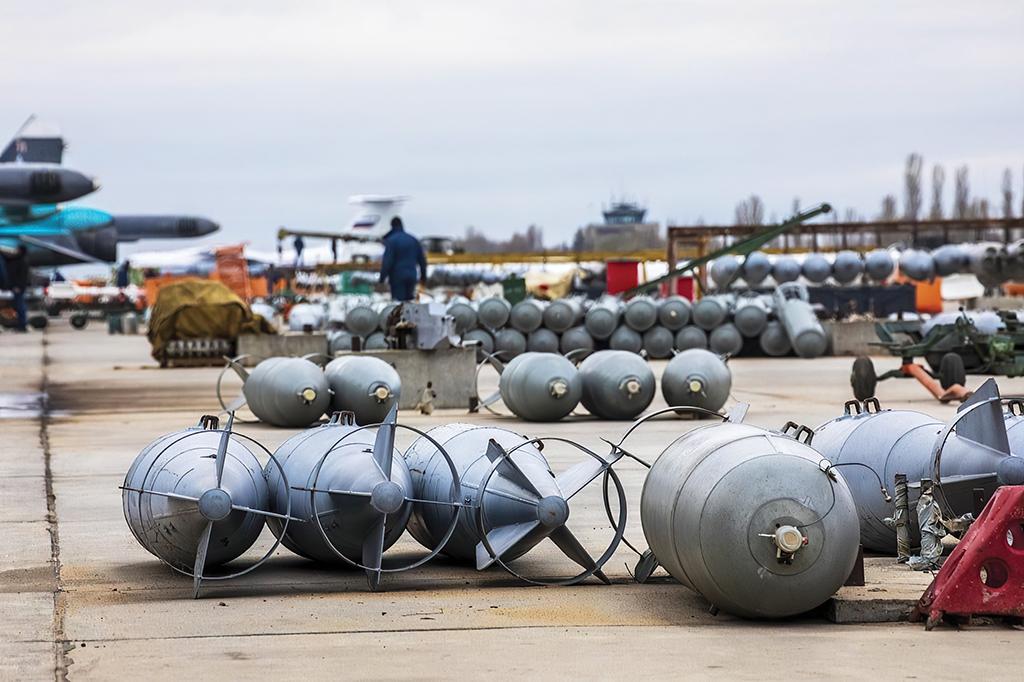
In more than two months of fighting in Ukraine, Russia has failed to control the airspace, despite dedicating a significant portion of its main aviation assets to the war.
About 60-70% of all Sukhoi Su-25s, Su-34s, Su-30SMs and Su-35S squadrons of the Russian Aerospace Forces (VKS) and the navy’s aviation units are estimated to have been involved. This is a significant burden for Russia, as it leaves little reserves.
And since the squadrons deployed for this fight are likely to be the best-trained aviators in the force, the remaining 30-40% are likely Russia’s weakest units.
Ukraine’s relative success was no accident. Its forces had been preparing for Russia to attack. Before the first strike, the country moved most of its combat aircraft to temporary airfields, including its many Soviet-era facilities. The Russians did not notice this maneuver, giving an indication of their relative lack of reconnaissance.
“The first strike of cruise missiles hit mockups in many places,” Ukrainian presidential advisor Oleksiy Arestovych says about the first day of the Russian invasion.
While Russia’s Air Force retains a numerical and qualitative advantage, Ukraine’s air defenses—rather than its aircraft—have prevented Russia from controlling the air.
The Russians have damaged some Ukrainian long-range stationary S-300P surface-to-air missile (SAM) systems with cruise and ballistic missile strikes. But medium-range mobile Buk-M1 systems remain operational.
This has forced Russian helicopters and close air support aircraft to operate at very low altitude, where they in turn fell victim to the massively present man-portable air defense systems.
Long-range anti-aircraft missiles are still critical to Ukraine’s defense, which is why the U.S. and its allies are working to obtain S-300 systems for Ukraine from various sources, including Slovakia.
“They’re being very nimble, very agile in how, when and where they apply air defense,” a U.S. defense official said about Ukrainian air defense on March 21. “I’m not just talking about shoulder-fired air defense, short-range, but also long-range mobile air defenses.”
Detailed real-time intelligence provided to Ukrainian forces by the U.S. and NATO, about when and where Russian missiles and bombs were intended to strike, cannot be overestimated. This intelligence has helped the Ukrainian air defense and air force to avoid blows.
According to U.S. defense officials, the Russian Air Force has performed an average of 200 crewed aircraft sorties per day, with several periods of increased intensity.
Ukraine conducts only 5-10 sorties per day, except for short periods of increased activity. Its actions are limited by the widespread presence of Russian long- and medium-range SAMs.
The Russians have lost only one Su-35S fighter, but those aircraft have largely stayed out of Ukraine. “A good number of Russian sorties never leave Russian airspace or Belarusian airspace,” a U.S. defense official revealed on March 21.
Losses of Su-25 close air support aircraft, Su-34 fighter-bombers and Su-30SM two-seat multirole fighters, which operate more deeply into Ukraine, have been more significant.
According to very conservative estimates, the Russian Air Force has lost at least five Su-30SMs and about 10 each of Su-25s and Su-34s. That is far below figures released by the Ukrainian Defense Ministry, which says that by May 3 Russia had lost 194 fixed-wing aircraft and 155 helicopters.
Likewise, there is no confirmation of Russian claims that 146 Ukrainian aircraft and 112 helicopters had been destroyed as of May 3. If taken seriously, it would mean Russia is starting to destroy the same aircraft a second time.
Russian aviation losses were greatest in the first days of March. Those losses decreased as missions became limited to fighter patrols at very high altitudes and significant standoff ranges, or strike sorties at low altitude.
Technically, modern Su-30SM, Su-34 and Su-35S aircraft can use both air-to-air missiles (AAM) and air-to-ground precision-guided munitions (PGM). However, in practice, use of PGMs by fighter aircraft as well as the use of AAMs by strike aircraft is rare. Pilots are not trained to use them, and fighter aircraft lack electro-optical targeting pods.
The Russians only recently started developing targeting pods for fighter aircraft. The KOEP-35 pod for the Su-35S and the Atoll-N pod for Su-57 fighters are presented at air shows, but it is unknown how many, if any, are actually in service.
Fighters
The Su-35S Flanker M is the service’s most advanced fighter aircraft, and it bears the brunt of the air superiority mission. Available footage shows that the Su-35Ss are flying typically armed with four R-77-1 beyond-visual-range AAMs and two R-73 or R-74M close-air-combat missiles.
On March 20, the Russian Defense Ministry published a video showing a combat sortie over Ukraine of Su-35S fighters armed with one or two Kh-31PM anti-radar missiles (ARM), in addition to standard air-to-air missiles. Two Russian Su-35S pilots boast in the film that they shot down Ukrainian aircraft.
The main task of the Su-35S was to fight Ukrainian aircraft; it uses the ARMs for self-defense against SAM systems. In self-defense mode, the pilot activates the missile’s passive radar seeker before entering the danger zone. The launch of a Kh-31PM missile takes place automatically when its seeker detects a working fire control radar of the enemy’s anti-aircraft missile system—within seconds, according to a Russian pilot.
According to the pilot, during the first days of the war, a large number of SAMs were fired during one Russian mission, but over time the Ukrainians have stopped trying to counter their aerial missions.
The first small batches of Kh-31PM missiles were made in 2012, first for the Su-34 fighter-bomber. Integration of the missile with Su-30SM and Su-35S fighters was completed around 2018-19. Russia first used the Kh-31PM operationally in Ukraine; before that it was seen only at air shows (in the export Kh-31PD form).
In another video published by the Russian Defense Ministry, the UPAB-1500B heavy-wing bomb is suspended under the wing of an Su-30SM or Su-35S fighter, its first appearance in an operational scenario. The bomb weighs 1,525 kg (3,362 lb.), of which 1,010 kg is the warhead. Thanks to the extendable wing, it reaches a range of up to 50 km (31 mi.).
It is guided to the target with coordinates given by inertial navigation with satellite correction; there is no terminal seeker in the current version. The UPAB-1500B bomb has been in production since 2019.
The second Russian fighter aircraft operating over Ukraine, the two-seat Su-30SM Flanker H, is usually armed with four R-27 medium-range AAMs in the R-27R radar and R-27T infrared versions and two small R-73 AAMs. Sometimes it carries 100-kg and 250-kg general purpose bombs. Strike tasks are assigned to the Su-30SM because of the second crewmember, the navigator and weapons operator.
According to the testimony of captured Su-30SM pilots from the 43rd Independent Naval Attack Aviation Regiment based in Saki, Crimea, the regiment was given three tasks when entering the war.
The first was the suppression/destruction of enemy air defenses (SEAD/DEAD), the second was protection of ground troops against Ukrainian aviation, and the third was support for a planned sea landing that was canceled after the first Russian failures in the war.
One captured Russian pilot said all seven sorties he made up to March 5, when he was shot down by a Ukrainian anti-aircraft missile, were SEAD/DEAD missions. The pilot did not say what weapons the Su-30SMs used for these tasks, but they had to be Kh-31P or Kh-31PM missiles.
The most active aircraft over Ukrainian territory are Su-34 Fullback heavy fighter-bombers and Su-25 Frogfoot close air support aircraft. They also suffered the greatest losses.
Kh-35U and Kh-59M2A anti-ship missiles have been used, most likely by the Su-34, on several occasions. Such missiles, while designed to counter surface ships, can also be used against radar-contrasting land targets. Both of these missiles are relatively new—or more precisely, they are new versions of the Kh-35 and Kh-59 missiles from the Soviet era.
There are images of the wreckage of two Kh-35U missiles that did not reach their intended targets in Ukraine and crashed, probably due to technical failures. One was found in Belarus, 30 km from Ukraine. Remains of another Kh-35U were found on April 4 in the Rostov region of Russia, more than 200 km from Ukraine, as if the missile had flown in the opposite direction.
The second anti-ship missile seen in Ukraine is the Raduga Kh-59M2A, in production in Smolensk since around 2015. This is its first known operational use. It is heavy for tactical aviation, weighing 930 kg, with a 320-kg warhead. Powered by a small turbofan, the missile flies to the target at a distance of 285 km, according to data for the export Kh-59MK version.
In addition to these new weapon types, the Russian Air Force is using its standard precision-guided missile arsenal in Ukraine. Photos show the legacy Kh-29 missiles in the laser- and TV-guided versions, as well as the laser KAB-1500L/LG and satellite-guided KAB-500S bombs. Undoubtedly, although there are no images confirming this, the most popular Russian KAB-500 guided bombs in the laser and TV versions are also used.
Unguided Weapons
In the first phase of the war, the Russian Air Force flew over Ukraine primarily with general purpose bombs and unguided rockets.
An Su-34 pilot from the 2nd Composite Aviation Regiment based in Chelyabinsk, whose squadron of 10 aircraft was deployed to the Seshcha air base before the war, was shot down on March 5 near Chernihiv and taken prisoner by Ukraine.
The pilot told a press conference in Kyiv that he used general purpose bombs in the three combat sorties, six 500-kg or eight 250-kg each. He conducted the bombing from high altitude on targets for which he was given the coordinates before the mission and which were routinely described to him as “concentrations of weapons and military equipment” or as a command post. He had no way of visually recognizing the target.
The Su-25 Frogfoot attack aircraft, the oldest combat aircraft of this war, are only seen over Ukraine with unguided weapons: 80-mm S-8 and 122-mm S-13 rockets and general purpose bombs.
There are no reliable estimates of Russian PGM stocks, but many missiles are believed to be available in relatively limited numbers. The production of new types of weapons is going slowly, and much of the old stocks were used up by Russia during the expeditionary operation in Syria that started in the autumn of 2015.
If the West manages to enforce an embargo on the supply of electronic components, Russia will have serious problems with the further production of precision-guided munitions (the same applies to aircraft equipment). Despite “import substitution” programs launched after 2014, the Russians still depend heavily on the import of electronic components.
Russia has no low-cost equivalent to the U.S. Joint Direct Attack Munition (JDAM). In contrast to U.S. aerial bombs, Russian general purpose bombs are welded monoliths. It is impossible to remove the tail section and replace it with a guidance unit, as the U.S. does with the JDAM. In the 2000s, the Russians tried to create a range-extension kit—a gliding module with an unfolding wing and a guidance device to which the bomb was attached—but they ended up with only plans.
Heavy Bombers
Russian strategic bombers have been involved in the war with Ukraine from Day 1. All reports mention the use of Tupolev Tu-95MS Bear H bombers. There is no information about Tu-160 Blackjack bombers also being used. The Tu-95MS bombers carry Kh-555 and Kh-101 strategic cruise missiles.
Images on social media have captured only the Kh-101 missiles in Ukraine. The stock of Kh-555 missiles, which are smaller and cheaper, was probably exhausted during Russian operations in Syria. The Kh-555 is a conversion of the older Kh-55 nuclear missile into a non-nuclear weapon; an unknown number of missiles were converted in the mid-2000s.
In addition to the air-launched Kh-101s, Russia is using similar land-based 9M728 Iskander-M and ship-launched 3M14 Kalibr cruise missiles. The Kh-101 missile is not difficult to distinguish from the other types, even in poor-quality images, because the engine hangs under the rear fuselage; the 9M728 and 3M14 missiles have engines built inside the fuselage.

Strategic air-launched missiles are being fired from outside Ukraine. The distance from the Russian Engels air base to the farthest part of Ukraine is 1,700 km, half the range of the Kh-101 missile.
During U.S. President Joe Biden’s visit to Poland on March 26, Russian strategic bombers fired the cruise missiles at a military training ground in Yavoriv in western Ukraine, 10 mi. from the Polish border. The same base was shelled by Russian airborne cruise missiles two weeks earlier.
On April 7, Russian President Vladimir Putin awarded the 121st Heavy Bomber Aviation Regiment in Engels—the only strategic bomber unit in the European part of Russia—the title of Guards, the most prestigious title for Russian military units, for heroism in combat operations.
According to a senior U.S. defense official, by May 2 Russia had launched more than 2,125 missiles of all classes into Ukraine. That is about 30 missile launches per day; the average for the first weeks of the war was around 50. It is unclear how many were air-launched. Ballistic and cruise missiles launched from the ground were by far the majority, and the share of cruise missiles launched from ships did not exceed 1-2%.
But many air-launched cruise missiles missed their intended targets. On March 21, a senior U.S. defense official said: “Either they’re failing to launch, or they’re failing to hit the target, or they’re failing to explode on contact.”
At the present stage of the war, when Russian ground troops are concentrated in the east and south after being pushed out of Kyiv, the Russian Air Force is conducting long-range strikes in central and western Ukraine, targeting military installations, defense production and repair plants, strategic fuel stocks and railway facilities. Russia is trying to cut supplies of military equipment from the West. On April 16, Russia’s Defense Ministry claimed the downing near Odessa of a transport aircraft delivering Western hardware to Ukraine; no evidence was provided.
Tu-22M3 Backfire C medium bombers joined the operation on April 15, when the defense ministry announced their use to bomb the Azovstal steel factory in Mariupol. The event also coincided with the sinking of the Moskva cruiser on April 14, after which the Russians briefly increased the intensity of retaliatory fire. The bombing of Mariupol by Tu-22M3s continued in the following days.
Hypersonic Missiles
The newest airborne weapons in the Russian inventory are hypersonic ballistic missiles shot from MiG-31K/I Kinzhal strike aircraft. The missile was used operationally for the first time on March 18 against an ammunition depot in Delatyn in western Ukraine, 70 km from the Romanian border.

The defense ministry said the Kinzhal missile struck “from a distance of more than 1,000 km,” while the missile flight lasted “less than 10 min.,” essentially with a speed of more than 6,000 kph (3,700 mph).
Two days later, the Russian Defense Ministry reported that a missile from a Kinzhal struck a fuel and materiel depot in Kostyantynivka in eastern Ukraine; the missile was launched “from the airspace over the territory of Crimea,” it said, a distance of 300-400 km. On April 11, the ministry said, a missile from a Kinzhal struck a “Ukrainian command post,” in Chasiv Yar in Donbas, just 30 km from the area occupied by Russian troops. The motivation for using the Kinzhal system is unclear; this may just be testing a new weapon in an operational environment.
Uncrewed Assets
Despite numerous declarations about the importance of uncrewed air vehicles (UAV) in modern warfare, numerous research and development programs and prototypes, and the large sums spent on them, the Russians have nothing in operational use that would rival the Turkish Bayraktar TB2 used in this war by Ukraine, not to mention the larger uncrewed systems. They have nothing in the high-altitude long-endurance class, and their one and only medium-altitude long-endurance drone, the Inokhodets, is still in single copies.
The Russians have turned to 18-kg Orlan-10 drones, which take off from a catapult and land on a parachute. A video of the dismantling of parts of the Russian Orlan-10, published by Ukrainians, indicates that it is mostly made of foreign components. The basic sensors are a Canon EOS 800D amateur photo camera and a Chinese thermal imager, the powerplant is a Japanese SAITO engine, and the fuel tank is a plastic drink bottle.
Images have shown the damage to the larger, 30-kg Orlan-30 UAV, and several times the even smaller 5-kg Eleron-3 and the 7-kg Tachyon surveillance drones, as well as the Zala KUB loitering munitions with a 3-kg explosive charge.
Completely unique are the air targets, probably used by the Russians to activate Ukrainian air defense systems: the Eniks E95M aircraft, weighing 75 kg and flying at 260 kph, and the Dinamika VM-V helicopter drone. The latter is a novelty that has been operated by the Russian Air Force since the end of 2020.
The Russians released a video of the Forpost-R, the largest UAV in Russian service among those used in noticeable numbers, operating over Ukraine. A Forpost-R with the number 007 took off from the civil Gomel Airport in Belarus and carried two 20-kg KAB-20 guided bombs.
For some time, there were doubts as to whether Russia was using its largest Inokhodets UAV over Ukraine (Orion is its export name). Photos indicate an Inokhodets was shot down by Ukrainian air defense on April 7.


Comments
Sounds similiar to the Battle of Britain, although with an even greater disparity than between Luftwaffe and RAF sorties.